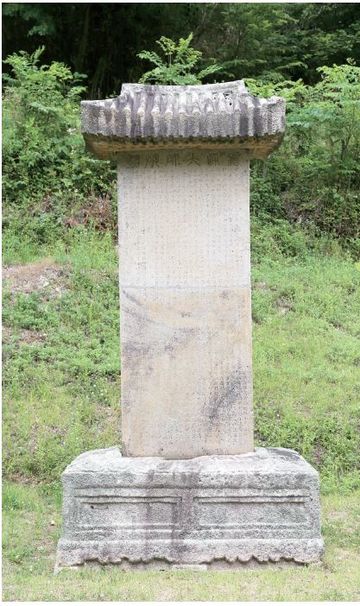"문경 봉암사 상봉대사비"의 두 판 사이의 차이
(→영문) |
(→영문) |
||
| 38번째 줄: | 38번째 줄: | ||
===영문=== | ===영문=== | ||
| − | '''Stele of Buddhist Monk Sangbong | + | '''Stele of Buddhist Monk Sangbong at Bongamsa Temple, Mungyeong''' |
| − | This stele was erected in 1716 to commemorate the life and achievements of the Buddhist monk Jeongwon (1627-1709), also known as Master Sangbong. | + | This stele was erected in 1716 to commemorate the life and achievements of the Buddhist monk Jeongwon (1627-1709), also known as Master Sangbong. Born in Yeongbyeon, Pyeongan-do Province, Jeongwon resided at several temples, including Haeinsa Temple in Hapcheon and Bongamsa Temple in Mungyeong, where he taught many students. The stele is said to have been found broken in two pieces next to a rice paddy and underwent a renovation at the temple. Its original location is unknown. |
| − | The stele measures 332 cm in height and consists of a rectangular pedestal, a body stone | + | The stele measures 332 cm in height and consists of a rectangular pedestal, a body stone, and a capstone shaped like a hip-and-gable roof. The pedestal is decorated with lotus and cloud designs, while the capstone features many carved elements that emulate parts of a traditional roof, such as roof tiles and wooden rafters. The body stone features an inscription composed by the renowned writer Yi Deok-su (1673-1744) and calligraphed by the calligrapher Yun Sun (1680-1741). |
| − | Made in the early 18th century, this stele marks the beginning of a popular trend for steles with rectangular pedestals and roof-shaped capstones. It demonstrates a high level of craftsmanship and is considered an exemplary masterpiece with great significance to the history of Buddhism and the history of culture and arts. | + | Made in the early 18th century, this stele marks the beginning of a popular trend for steles with rectangular pedestals and roof-shaped capstones. It demonstrates a high level of craftsmanship and is considered an exemplary masterpiece with great significance to the history of Buddhism and the history of culture and the arts. |
| + | |||
| + | *안드리가 "기왓골, 추녀, 사래, 부연" 간략하게 번역했는데 좋을 것 같아요. | ||
===영문 해설 내용=== | ===영문 해설 내용=== | ||
2023년 11월 6일 (월) 19:37 판
| 문경 봉암사 상봉대사비 |
|
 문경 봉암사 상봉대사비, 불교중앙박물관. |
|
| 대표명칭 | 문경 봉암사 상봉대사비 |
|---|---|
| 한자 | 聞慶 鳳巖寺 霜峰大師碑 |
| 지정번호 | 경상북도 유형문화재 |
| 지정일 | 2022년 3월 21일 |
| 분류 | 유적건조물 / 종교신앙 / 불교 / 기타 |
| 수량/면적 | 1기 |
| 웹사이트 | 문경 봉암사 상봉대사비, 국가문화유산포털, 문화재청. |
해설문
국문
이 비석은 조선 후기 법맥의 한 축을 형성하고 있는 상봉당 정원대사(1627-1709)의 행적을 기록한 비로 1716년에 건립되었다. 비의 몸돌이 두동강이 난 채로 논가에 방치되어 있던 것을 봉암사에서 복원하였다고 전해져 현재 위치가 본래 자리인지는 알 수 없다.
비문은 당대 문장가인 이덕수(1673-1744)가 지었으며, 서화가인 윤순(1680-1741)이 글씨를 썼다. 또한 석수는 1729년 문경 대승사 노주석(경상북도 유형문화유산)을 조성한 이영위이다. 전체 높이는 332㎝이며 받침돌, 몸돌, 머릿돌로 구성하였다. 받침돌은 방부형이며 연판문과 운족을 표현하였다. 머릿돌은 개석형으로 팔작지붕을 번안하여 기왓골, 추녀, 사래, 부연 등을 섬세하게 조각하였다.
<문경 봉암사 상봉대사비>는 18세기 가장 이른 시기에 조성된 방부개석 형식의 고승비로 건립연대가 명확하며 이후 건립되는 고승비 형식에 많은 영향을 주었다. 또한 조선 후기 건립되는 고승비 가운데 조형적으로 뛰어나 모범이 되며, 불교사 및 문화예술사적으로 의의가 있는 작품으로 평가할 수 있다.
- 연판문(蓮瓣文): 펼쳐놓은 연꽃잎 모양을 도안화한 무늬
- 운족(雲足): 구름 모양 다리
- 추녀: 처마의 네 모퉁이에서 지붕의 하중을 받는 건축부재
- 사래: 추녀 끝에 설치하여 겹처마를 이루게 하는 건축부재
- 부연: 서까래 위에 덧붙이는 서까래로 서까래와 부연이 함께 꾸며지는 처마를 겹처마라고 함
- 방부개석: 사각형의 받침돌과 지붕모양의 덮개돌
영문
Stele of Buddhist Monk Sangbong at Bongamsa Temple, Mungyeong
This stele was erected in 1716 to commemorate the life and achievements of the Buddhist monk Jeongwon (1627-1709), also known as Master Sangbong. Born in Yeongbyeon, Pyeongan-do Province, Jeongwon resided at several temples, including Haeinsa Temple in Hapcheon and Bongamsa Temple in Mungyeong, where he taught many students. The stele is said to have been found broken in two pieces next to a rice paddy and underwent a renovation at the temple. Its original location is unknown.
The stele measures 332 cm in height and consists of a rectangular pedestal, a body stone, and a capstone shaped like a hip-and-gable roof. The pedestal is decorated with lotus and cloud designs, while the capstone features many carved elements that emulate parts of a traditional roof, such as roof tiles and wooden rafters. The body stone features an inscription composed by the renowned writer Yi Deok-su (1673-1744) and calligraphed by the calligrapher Yun Sun (1680-1741).
Made in the early 18th century, this stele marks the beginning of a popular trend for steles with rectangular pedestals and roof-shaped capstones. It demonstrates a high level of craftsmanship and is considered an exemplary masterpiece with great significance to the history of Buddhism and the history of culture and the arts.
- 안드리가 "기왓골, 추녀, 사래, 부연" 간략하게 번역했는데 좋을 것 같아요.
영문 해설 내용
이 탑비는 조선시대의 승려인 상봉대사 정원(1627-1709)의 생애와 업적을 기리기 위해 1716년에 건립되었다. 정원은 평안도 영변 출신으로 합천의 해인사와 문경 봉암사 등에서 수행하며 여러 제자들을 길러냈다. 이 탑비는 몸돌이 두 동강이 난 채로 논가에 방치되어 있던 것을 봉암사에서 복원하였다고 전해지며, 현재 위치가 본래 자리인지는 알 수 없다.
탑비의 전체 높이는 332㎝이며 네모난 받침돌, 비문을 새긴 몸돌, 팔작지붕 모양의 머릿돌로 이루어져 있다. 받침돌에는 연꽃잎을 펼쳐 놓은 문양과 구름 모양을 새겨 장식하였다. 머릿돌에는 기왓골, 추녀, 사래, 부연 등을 섬세하게 조각하여 실제 지붕의 모습을 표현하였다. 비문은 당대 문장가인 이덕수(1673-1744)가 지었으며, 서화가인 윤순(1680-1741)이 글씨를 썼다.
이 비석은 18세기 초에 조성된 사각형의 받침돌과 지붕 모양의 덮개돌로 이루어진 탑비로, 건립연대가 명확하며 이후 건립되는 탑비 형식에 많은 영향을 주었다. 또한 조선 후기 건립되는 탑비 가운데 조형적으로 뛰어나 모범이 되며, 불교사 및 문화예술사적으로 의의가 있는 작품으로 평가할 수 있다.